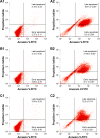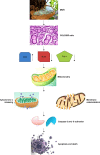Phytochemical analysis and antioxidant and anticancer activities of mastic gum resin from Pistacia atlantica subspecies kurdica
- PMID: 30122948
- PMCID: PMC6084073
- DOI: 10.2147/OTT.S170827
Phytochemical analysis and antioxidant and anticancer activities of mastic gum resin from Pistacia atlantica subspecies kurdica
Abstract
Background: The mastic gum resin has been used in traditional Kurdish medicine for treating various disorders such as topical wound and gastric ulcer. The study designed to evaluate the total polyphenol and flavonoid content, free radical scavenging activity, and anticancer effects of mastic gum resin derived from Pistacia atlantica subspecies kurdica.
Materials and methods: Folin -Ciocalteau and the aluminum chloride colorimetric assays were used to determine the total phenol and flavonoid contents in the mastic gum resin respectively. Whereas, DPPH and ABTS+ assays were used to determine the antioxidant activities of mastic gum resin. Regarding anticancer activities, the MTT assay was used to study the effect of mastic gum resin on the proliferation of various cancer cells and the morphological changes were identified after Acridine Orange/Propidium Iodide staining. Flow cytometry was applied to determine the influence of mastic gum resin on the apoptosis rate by Annexin V double staining and to investigate the influence on cell cycle progression. Caspase colorimetric assay was used to estimate the hallmark enzyme of apoptosis, and finally RNA were obtained from COLO205 cells and analyzed by qRT-PCR analyses.
Results: The MTT results showed that the mastic gum resin at concentrations from 0.01 to 100 μM induced death of cancer cells in a dose and time-dependent manner. The mastic gum resin suppressed proliferation of human cancer cells with 72 h IC50 value of 15.34 ± 0.21, 11.52 ± 0.18, 8.11 ± 0.23 and 5.2 ± 0.8 μg/mL for bile duct cancer (cholangiocarcinoma) (KMBC), pancreatic carcinoma (PANC-1), gastric adenocarcinoma (CRL-1739), and colonic adenocarcinoma (COLO205) cells, respectively. Normal human colon fibroblast (CCD-18Co) cells were not adversely affected by resin treatment. Flow cytometry showed that the mastic gum resin significantly (P<0.05) arrested COLO205 cell proliferation at the G2/M phase of cell cycle. The resin caused apoptotic morphological changes in COLO205 cells. The apoptotic effect to mastic gum resin was via the mitochondrial as shown by the up-regulation of Bax, down-regulation of Bcl-2 genes, and activation of caspase-9 and -3 activities.
Conclusion: It was confirmed that the antiproliferative efficacy of the resin is positively correlated with its polyphenolic contents, suggesting a causal link related to exudate content of phenolic acid and flavonoids. The results revealed that the mastic gum resin has potential to be developed as an anticancer and antioxidant product due to its high content of polyphenol compounds.
Keywords: apoptosis; free radical scavenging; natural plant exudate; polyphenolic contents.
Conflict of interest statement
Disclosure The author reports no conflicts of interest in this work.
Figures










Similar articles
-
Traditional uses, phytochemistry and pharmacology of Chios mastic gum (Pistacia lentiscus var. Chia, Anacardiaceae): A review.J Ethnopharmacol. 2020 May 23;254:112485. doi: 10.1016/j.jep.2019.112485. Epub 2020 Feb 22. J Ethnopharmacol. 2020. PMID: 32092498 Review.
-
Cyto/Genotoxic Effects of Pistacia atlantica Resin, a Traditional Gum.DNA Cell Biol. 2016 Jun;35(6):261-6. doi: 10.1089/dna.2015.3048. Epub 2016 May 19. DNA Cell Biol. 2016. PMID: 27196631
-
Chemical characteristics and biological activity screening of Pistacia lentiscus mastic gum and leaves from Türkiye.J Sci Food Agric. 2024 Feb;104(3):1691-1701. doi: 10.1002/jsfa.13056. Epub 2023 Nov 16. J Sci Food Agric. 2024. PMID: 37870092
-
Gemcitabine combined with gum mastic causes potent growth inhibition and apoptosis of pancreatic cancer cells.Acta Pharmacol Sin. 2010 Jun;31(6):741-5. doi: 10.1038/aps.2010.54. Acta Pharmacol Sin. 2010. PMID: 20523344 Free PMC article.
-
Current evidence on the anticancer potential of Chios mastic gum.Nutr Cancer. 2011 Nov;63(8):1174-84. doi: 10.1080/01635581.2011.607546. Epub 2011 Nov 1. Nutr Cancer. 2011. PMID: 22044444 Review.
Cited by
-
Multiplicative Effects of Essential Oils and Other Active Components on Skin Tissue and Skin Cancers.Int J Mol Sci. 2024 May 15;25(10):5397. doi: 10.3390/ijms25105397. Int J Mol Sci. 2024. PMID: 38791435 Free PMC article. Review.
-
A Traditional Gum Exudate From Pistacia atlantica Ameliorates Etha-Nol-Mediated Gastric Ulcer in Rats: Possible Molecular Mechanisms.Food Sci Nutr. 2025 Mar 2;13(3):e70049. doi: 10.1002/fsn3.70049. eCollection 2025 Mar. Food Sci Nutr. 2025. PMID: 40034223 Free PMC article.
-
Evaluation of the cytotoxic activities of the essential oil from Pistacia atlantica Desf. oleoresin on human gastric cancer cell lines.Med Oncol. 2024 May 11;41(6):148. doi: 10.1007/s12032-024-02339-z. Med Oncol. 2024. PMID: 38733486
-
Why Should Pistachio Be a Regular Food in Our Diet?Nutrients. 2022 Aug 5;14(15):3207. doi: 10.3390/nu14153207. Nutrients. 2022. PMID: 35956383 Free PMC article. Review.
-
Nutraceutical Content and Biological Properties of Lipophilic and Hydrophilic Fractions of the Phytocomplex from Pistacia atlantica Desf. Buds, Roots, and Fruits.Plants (Basel). 2024 Feb 23;13(5):611. doi: 10.3390/plants13050611. Plants (Basel). 2024. PMID: 38475458 Free PMC article.
References
-
- Giaginis C, Theocharis S. Current evidence on the anticancer potential of Chios mastic gum. Nutr Cancer. 2011;63(8):1174–1184. - PubMed
LinkOut - more resources
Full Text Sources
Other Literature Sources
Research Materials

